Impact of Nutrition and Western Diets on Immigrant Health in Canada
VerifiedAdded on 2022/08/27
|9
|2317
|16
Essay
AI Summary
This essay examines the impact of nutrition, particularly the adoption of a Western diet, on the health of immigrants in Canada, with a focus on South Asians and Latin American newcomers. It highlights the increased risk of food insecurity and nutrition-related diseases such as cardiovascular disease and type 2 diabetes among these populations. The essay explores the driving forces behind dietary changes, including the nutrition transition due to industrialization and globalization, as well as dietary acculturation. It emphasizes the role of readily available, ultra-processed foods high in fats, sugar, and refined carbohydrates. The essay also discusses the Canadian government's role in promoting healthy eating through guidelines, regulations, and collaborations to ensure better food environments for both Canadians and immigrants, advocating for strategies like revising the Canada's Food Guide and reducing sodium levels in food products.
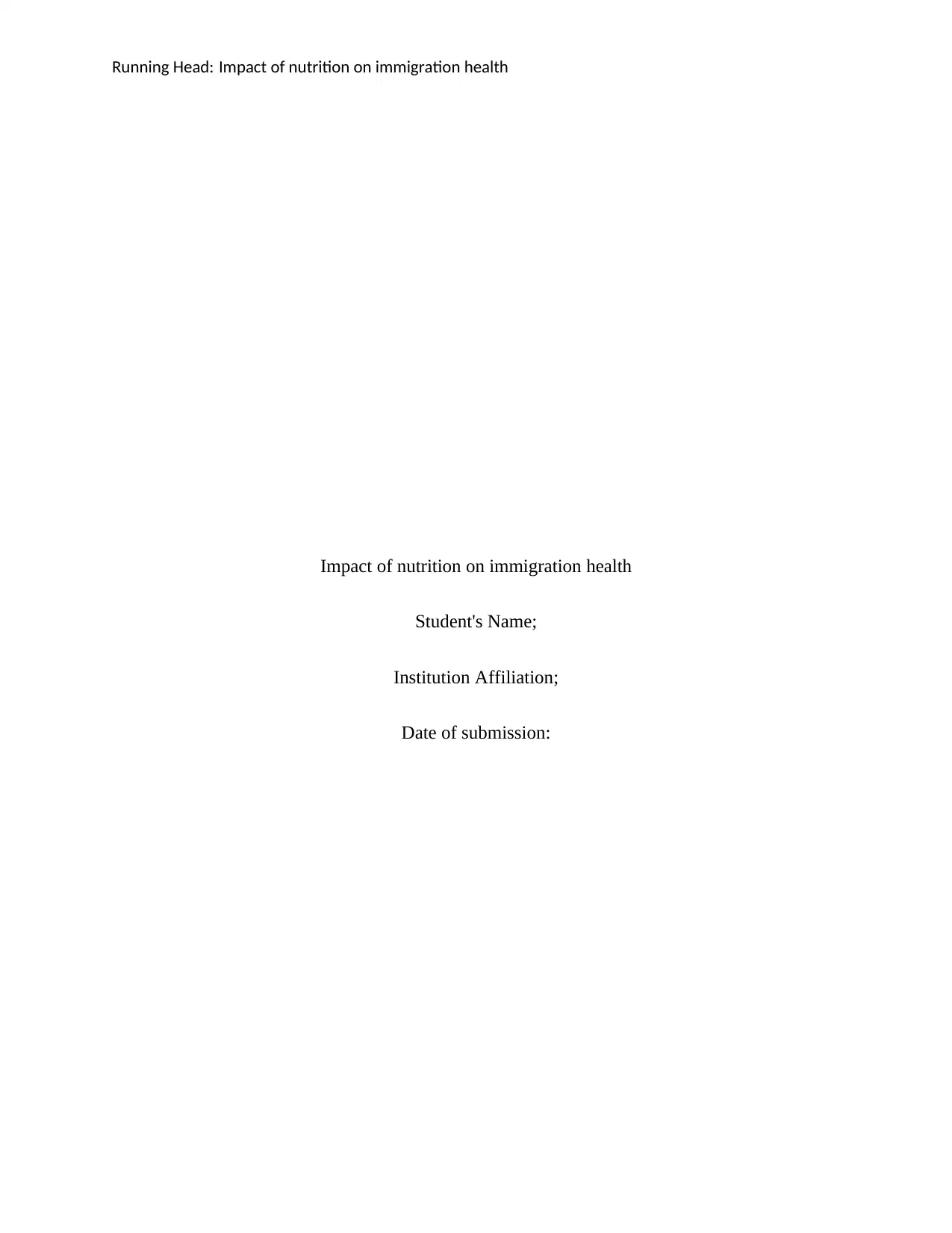
Running Head: Impact of nutrition on immigration health
Impact of nutrition on immigration health
Student's Name;
Institution Affiliation;
Date of submission:
Impact of nutrition on immigration health
Student's Name;
Institution Affiliation;
Date of submission:
Paraphrase This Document
Need a fresh take? Get an instant paraphrase of this document with our AI Paraphraser
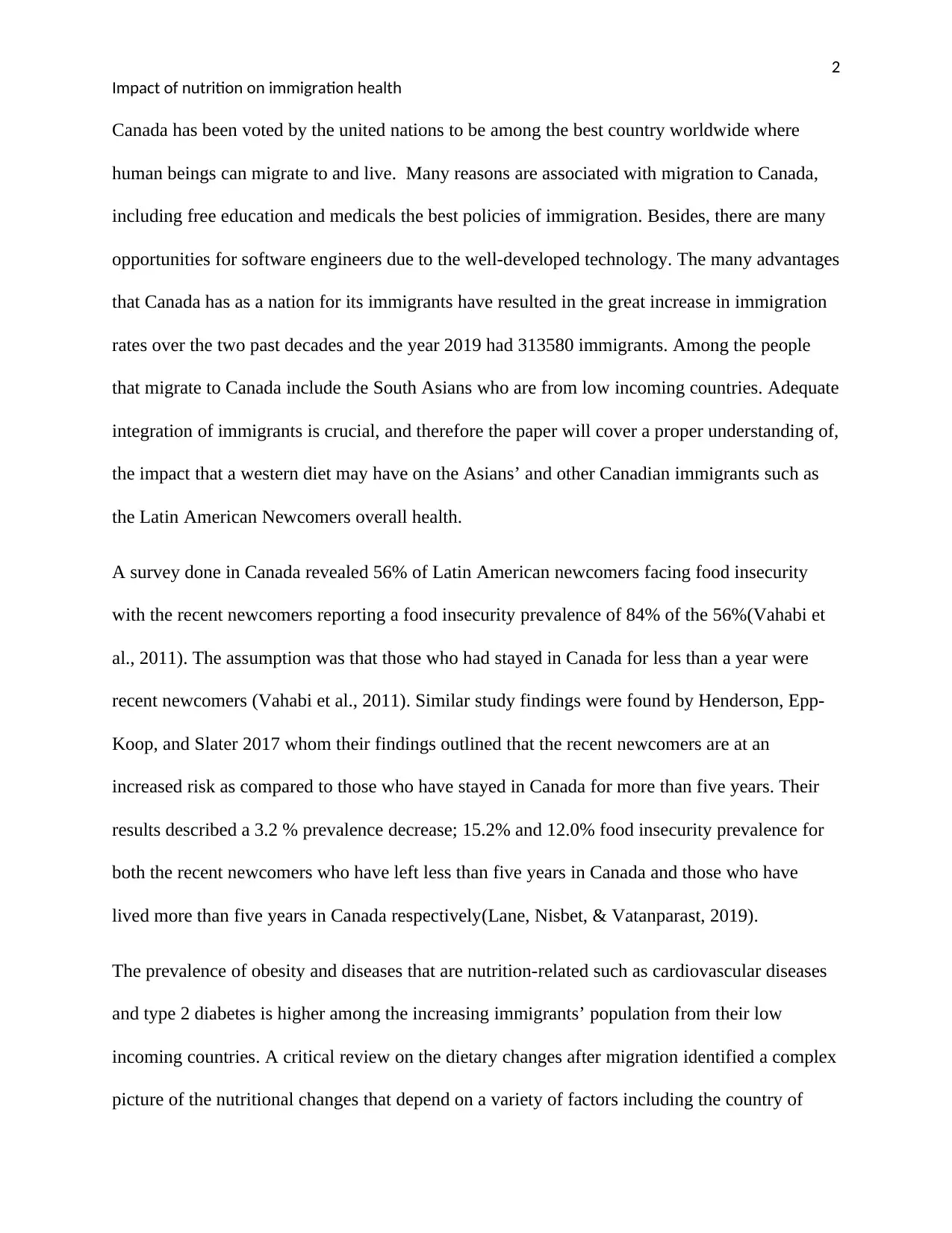
2
Impact of nutrition on immigration health
Canada has been voted by the united nations to be among the best country worldwide where
human beings can migrate to and live. Many reasons are associated with migration to Canada,
including free education and medicals the best policies of immigration. Besides, there are many
opportunities for software engineers due to the well-developed technology. The many advantages
that Canada has as a nation for its immigrants have resulted in the great increase in immigration
rates over the two past decades and the year 2019 had 313580 immigrants. Among the people
that migrate to Canada include the South Asians who are from low incoming countries. Adequate
integration of immigrants is crucial, and therefore the paper will cover a proper understanding of,
the impact that a western diet may have on the Asians’ and other Canadian immigrants such as
the Latin American Newcomers overall health.
A survey done in Canada revealed 56% of Latin American newcomers facing food insecurity
with the recent newcomers reporting a food insecurity prevalence of 84% of the 56%(Vahabi et
al., 2011). The assumption was that those who had stayed in Canada for less than a year were
recent newcomers (Vahabi et al., 2011). Similar study findings were found by Henderson, Epp-
Koop, and Slater 2017 whom their findings outlined that the recent newcomers are at an
increased risk as compared to those who have stayed in Canada for more than five years. Their
results described a 3.2 % prevalence decrease; 15.2% and 12.0% food insecurity prevalence for
both the recent newcomers who have left less than five years in Canada and those who have
lived more than five years in Canada respectively(Lane, Nisbet, & Vatanparast, 2019).
The prevalence of obesity and diseases that are nutrition-related such as cardiovascular diseases
and type 2 diabetes is higher among the increasing immigrants’ population from their low
incoming countries. A critical review on the dietary changes after migration identified a complex
picture of the nutritional changes that depend on a variety of factors including the country of
Impact of nutrition on immigration health
Canada has been voted by the united nations to be among the best country worldwide where
human beings can migrate to and live. Many reasons are associated with migration to Canada,
including free education and medicals the best policies of immigration. Besides, there are many
opportunities for software engineers due to the well-developed technology. The many advantages
that Canada has as a nation for its immigrants have resulted in the great increase in immigration
rates over the two past decades and the year 2019 had 313580 immigrants. Among the people
that migrate to Canada include the South Asians who are from low incoming countries. Adequate
integration of immigrants is crucial, and therefore the paper will cover a proper understanding of,
the impact that a western diet may have on the Asians’ and other Canadian immigrants such as
the Latin American Newcomers overall health.
A survey done in Canada revealed 56% of Latin American newcomers facing food insecurity
with the recent newcomers reporting a food insecurity prevalence of 84% of the 56%(Vahabi et
al., 2011). The assumption was that those who had stayed in Canada for less than a year were
recent newcomers (Vahabi et al., 2011). Similar study findings were found by Henderson, Epp-
Koop, and Slater 2017 whom their findings outlined that the recent newcomers are at an
increased risk as compared to those who have stayed in Canada for more than five years. Their
results described a 3.2 % prevalence decrease; 15.2% and 12.0% food insecurity prevalence for
both the recent newcomers who have left less than five years in Canada and those who have
lived more than five years in Canada respectively(Lane, Nisbet, & Vatanparast, 2019).
The prevalence of obesity and diseases that are nutrition-related such as cardiovascular diseases
and type 2 diabetes is higher among the increasing immigrants’ population from their low
incoming countries. A critical review on the dietary changes after migration identified a complex
picture of the nutritional changes that depend on a variety of factors including the country of
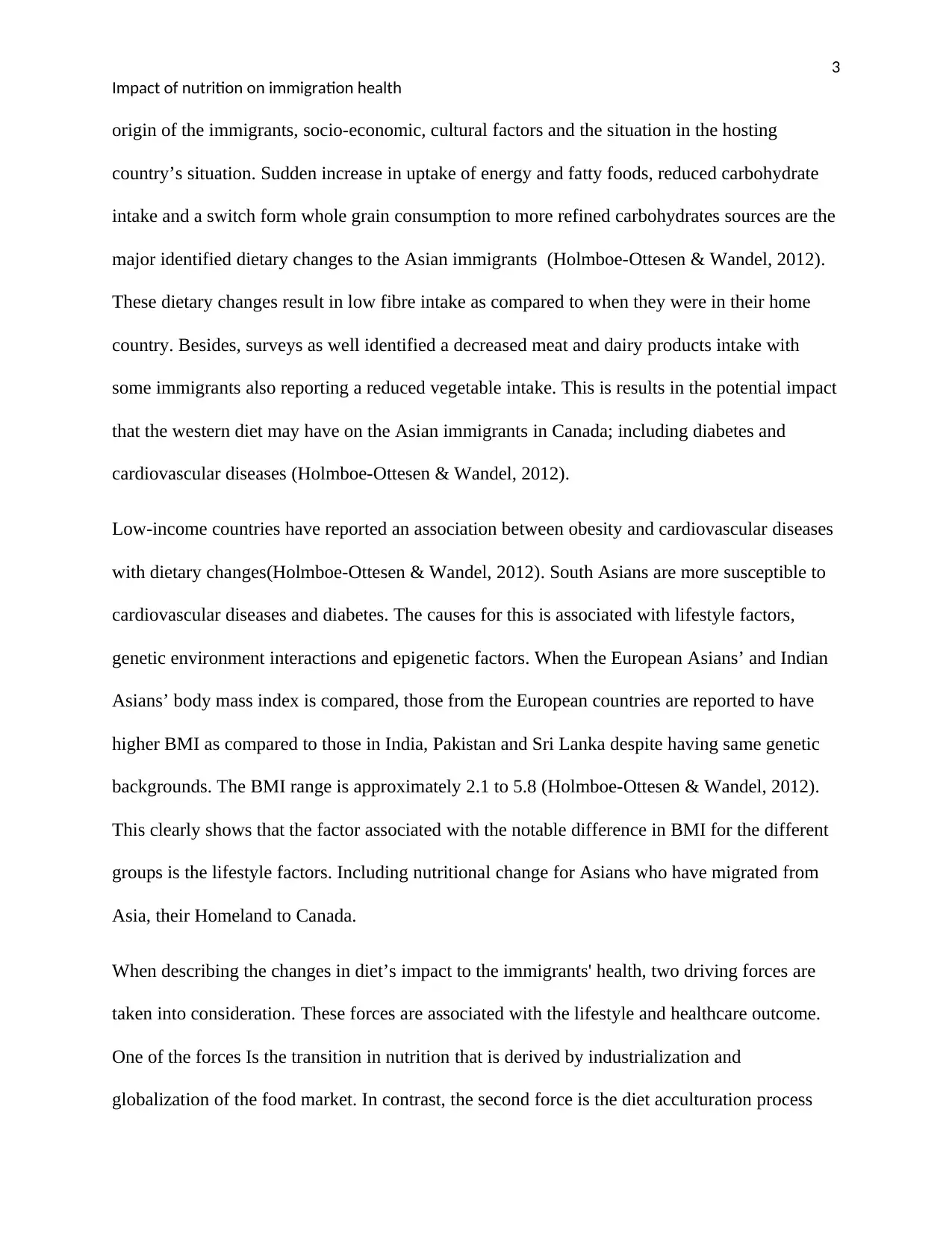
3
Impact of nutrition on immigration health
origin of the immigrants, socio-economic, cultural factors and the situation in the hosting
country’s situation. Sudden increase in uptake of energy and fatty foods, reduced carbohydrate
intake and a switch form whole grain consumption to more refined carbohydrates sources are the
major identified dietary changes to the Asian immigrants (Holmboe-Ottesen & Wandel, 2012).
These dietary changes result in low fibre intake as compared to when they were in their home
country. Besides, surveys as well identified a decreased meat and dairy products intake with
some immigrants also reporting a reduced vegetable intake. This is results in the potential impact
that the western diet may have on the Asian immigrants in Canada; including diabetes and
cardiovascular diseases (Holmboe-Ottesen & Wandel, 2012).
Low-income countries have reported an association between obesity and cardiovascular diseases
with dietary changes(Holmboe-Ottesen & Wandel, 2012). South Asians are more susceptible to
cardiovascular diseases and diabetes. The causes for this is associated with lifestyle factors,
genetic environment interactions and epigenetic factors. When the European Asians’ and Indian
Asians’ body mass index is compared, those from the European countries are reported to have
higher BMI as compared to those in India, Pakistan and Sri Lanka despite having same genetic
backgrounds. The BMI range is approximately 2.1 to 5.8 (Holmboe-Ottesen & Wandel, 2012).
This clearly shows that the factor associated with the notable difference in BMI for the different
groups is the lifestyle factors. Including nutritional change for Asians who have migrated from
Asia, their Homeland to Canada.
When describing the changes in diet’s impact to the immigrants' health, two driving forces are
taken into consideration. These forces are associated with the lifestyle and healthcare outcome.
One of the forces Is the transition in nutrition that is derived by industrialization and
globalization of the food market. In contrast, the second force is the diet acculturation process
Impact of nutrition on immigration health
origin of the immigrants, socio-economic, cultural factors and the situation in the hosting
country’s situation. Sudden increase in uptake of energy and fatty foods, reduced carbohydrate
intake and a switch form whole grain consumption to more refined carbohydrates sources are the
major identified dietary changes to the Asian immigrants (Holmboe-Ottesen & Wandel, 2012).
These dietary changes result in low fibre intake as compared to when they were in their home
country. Besides, surveys as well identified a decreased meat and dairy products intake with
some immigrants also reporting a reduced vegetable intake. This is results in the potential impact
that the western diet may have on the Asian immigrants in Canada; including diabetes and
cardiovascular diseases (Holmboe-Ottesen & Wandel, 2012).
Low-income countries have reported an association between obesity and cardiovascular diseases
with dietary changes(Holmboe-Ottesen & Wandel, 2012). South Asians are more susceptible to
cardiovascular diseases and diabetes. The causes for this is associated with lifestyle factors,
genetic environment interactions and epigenetic factors. When the European Asians’ and Indian
Asians’ body mass index is compared, those from the European countries are reported to have
higher BMI as compared to those in India, Pakistan and Sri Lanka despite having same genetic
backgrounds. The BMI range is approximately 2.1 to 5.8 (Holmboe-Ottesen & Wandel, 2012).
This clearly shows that the factor associated with the notable difference in BMI for the different
groups is the lifestyle factors. Including nutritional change for Asians who have migrated from
Asia, their Homeland to Canada.
When describing the changes in diet’s impact to the immigrants' health, two driving forces are
taken into consideration. These forces are associated with the lifestyle and healthcare outcome.
One of the forces Is the transition in nutrition that is derived by industrialization and
globalization of the food market. In contrast, the second force is the diet acculturation process
⊘ This is a preview!⊘
Do you want full access?
Subscribe today to unlock all pages.

Trusted by 1+ million students worldwide
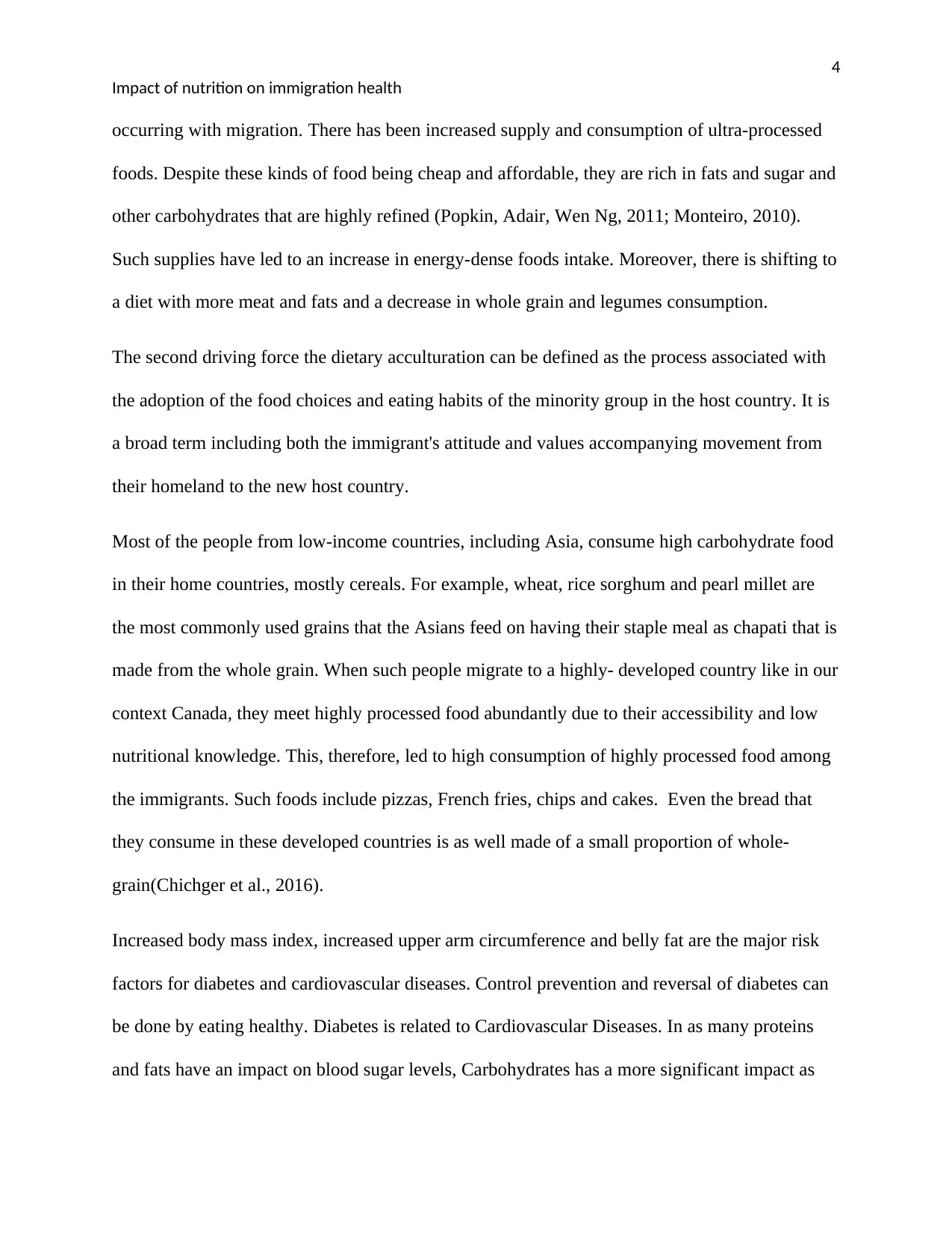
4
Impact of nutrition on immigration health
occurring with migration. There has been increased supply and consumption of ultra-processed
foods. Despite these kinds of food being cheap and affordable, they are rich in fats and sugar and
other carbohydrates that are highly refined (Popkin, Adair, Wen Ng, 2011; Monteiro, 2010).
Such supplies have led to an increase in energy-dense foods intake. Moreover, there is shifting to
a diet with more meat and fats and a decrease in whole grain and legumes consumption.
The second driving force the dietary acculturation can be defined as the process associated with
the adoption of the food choices and eating habits of the minority group in the host country. It is
a broad term including both the immigrant's attitude and values accompanying movement from
their homeland to the new host country.
Most of the people from low-income countries, including Asia, consume high carbohydrate food
in their home countries, mostly cereals. For example, wheat, rice sorghum and pearl millet are
the most commonly used grains that the Asians feed on having their staple meal as chapati that is
made from the whole grain. When such people migrate to a highly- developed country like in our
context Canada, they meet highly processed food abundantly due to their accessibility and low
nutritional knowledge. This, therefore, led to high consumption of highly processed food among
the immigrants. Such foods include pizzas, French fries, chips and cakes. Even the bread that
they consume in these developed countries is as well made of a small proportion of whole-
grain(Chichger et al., 2016).
Increased body mass index, increased upper arm circumference and belly fat are the major risk
factors for diabetes and cardiovascular diseases. Control prevention and reversal of diabetes can
be done by eating healthy. Diabetes is related to Cardiovascular Diseases. In as many proteins
and fats have an impact on blood sugar levels, Carbohydrates has a more significant impact as
Impact of nutrition on immigration health
occurring with migration. There has been increased supply and consumption of ultra-processed
foods. Despite these kinds of food being cheap and affordable, they are rich in fats and sugar and
other carbohydrates that are highly refined (Popkin, Adair, Wen Ng, 2011; Monteiro, 2010).
Such supplies have led to an increase in energy-dense foods intake. Moreover, there is shifting to
a diet with more meat and fats and a decrease in whole grain and legumes consumption.
The second driving force the dietary acculturation can be defined as the process associated with
the adoption of the food choices and eating habits of the minority group in the host country. It is
a broad term including both the immigrant's attitude and values accompanying movement from
their homeland to the new host country.
Most of the people from low-income countries, including Asia, consume high carbohydrate food
in their home countries, mostly cereals. For example, wheat, rice sorghum and pearl millet are
the most commonly used grains that the Asians feed on having their staple meal as chapati that is
made from the whole grain. When such people migrate to a highly- developed country like in our
context Canada, they meet highly processed food abundantly due to their accessibility and low
nutritional knowledge. This, therefore, led to high consumption of highly processed food among
the immigrants. Such foods include pizzas, French fries, chips and cakes. Even the bread that
they consume in these developed countries is as well made of a small proportion of whole-
grain(Chichger et al., 2016).
Increased body mass index, increased upper arm circumference and belly fat are the major risk
factors for diabetes and cardiovascular diseases. Control prevention and reversal of diabetes can
be done by eating healthy. Diabetes is related to Cardiovascular Diseases. In as many proteins
and fats have an impact on blood sugar levels, Carbohydrates has a more significant impact as
Paraphrase This Document
Need a fresh take? Get an instant paraphrase of this document with our AI Paraphraser
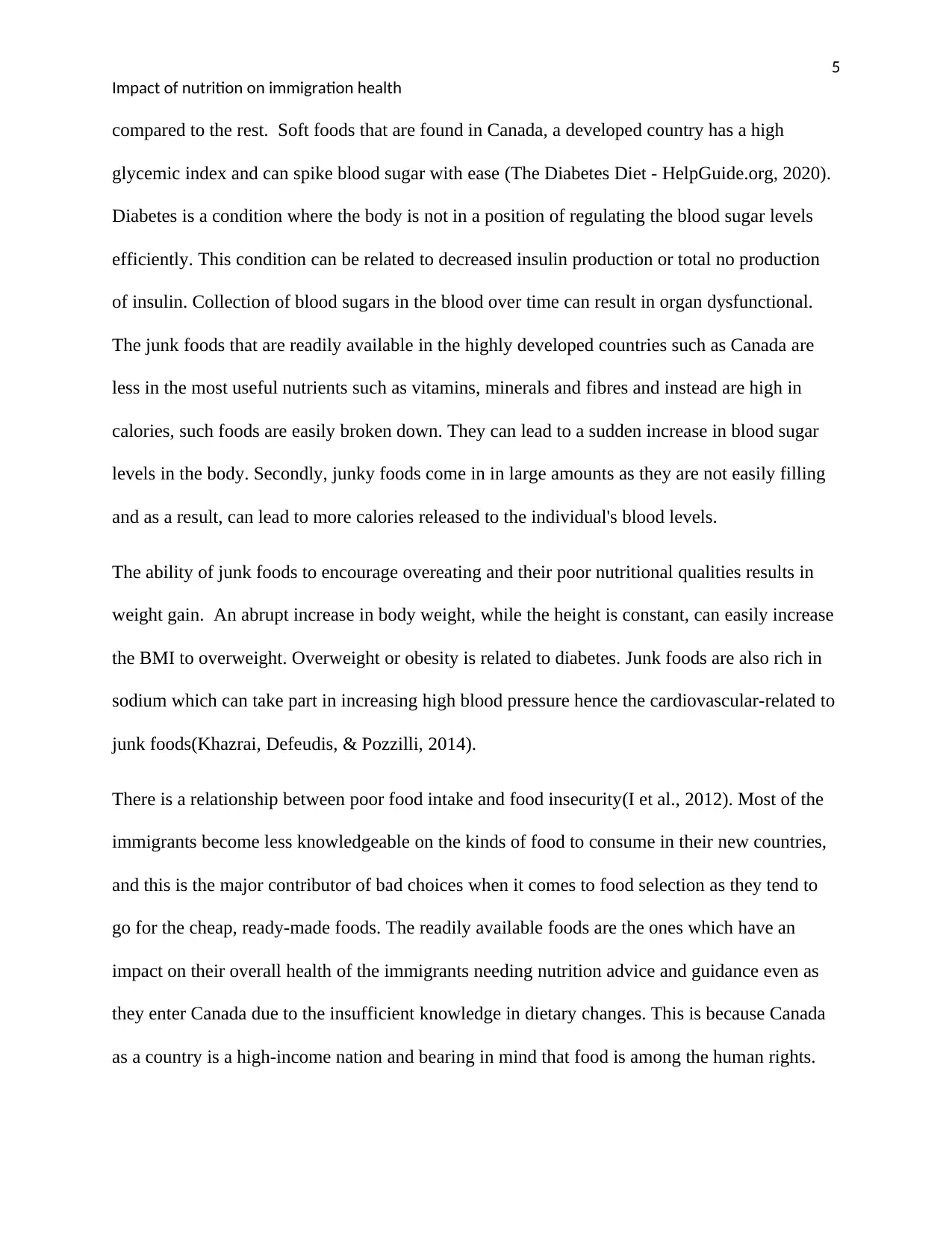
5
Impact of nutrition on immigration health
compared to the rest. Soft foods that are found in Canada, a developed country has a high
glycemic index and can spike blood sugar with ease (The Diabetes Diet - HelpGuide.org, 2020).
Diabetes is a condition where the body is not in a position of regulating the blood sugar levels
efficiently. This condition can be related to decreased insulin production or total no production
of insulin. Collection of blood sugars in the blood over time can result in organ dysfunctional.
The junk foods that are readily available in the highly developed countries such as Canada are
less in the most useful nutrients such as vitamins, minerals and fibres and instead are high in
calories, such foods are easily broken down. They can lead to a sudden increase in blood sugar
levels in the body. Secondly, junky foods come in in large amounts as they are not easily filling
and as a result, can lead to more calories released to the individual's blood levels.
The ability of junk foods to encourage overeating and their poor nutritional qualities results in
weight gain. An abrupt increase in body weight, while the height is constant, can easily increase
the BMI to overweight. Overweight or obesity is related to diabetes. Junk foods are also rich in
sodium which can take part in increasing high blood pressure hence the cardiovascular-related to
junk foods(Khazrai, Defeudis, & Pozzilli, 2014).
There is a relationship between poor food intake and food insecurity(I et al., 2012). Most of the
immigrants become less knowledgeable on the kinds of food to consume in their new countries,
and this is the major contributor of bad choices when it comes to food selection as they tend to
go for the cheap, ready-made foods. The readily available foods are the ones which have an
impact on their overall health of the immigrants needing nutrition advice and guidance even as
they enter Canada due to the insufficient knowledge in dietary changes. This is because Canada
as a country is a high-income nation and bearing in mind that food is among the human rights.
Impact of nutrition on immigration health
compared to the rest. Soft foods that are found in Canada, a developed country has a high
glycemic index and can spike blood sugar with ease (The Diabetes Diet - HelpGuide.org, 2020).
Diabetes is a condition where the body is not in a position of regulating the blood sugar levels
efficiently. This condition can be related to decreased insulin production or total no production
of insulin. Collection of blood sugars in the blood over time can result in organ dysfunctional.
The junk foods that are readily available in the highly developed countries such as Canada are
less in the most useful nutrients such as vitamins, minerals and fibres and instead are high in
calories, such foods are easily broken down. They can lead to a sudden increase in blood sugar
levels in the body. Secondly, junky foods come in in large amounts as they are not easily filling
and as a result, can lead to more calories released to the individual's blood levels.
The ability of junk foods to encourage overeating and their poor nutritional qualities results in
weight gain. An abrupt increase in body weight, while the height is constant, can easily increase
the BMI to overweight. Overweight or obesity is related to diabetes. Junk foods are also rich in
sodium which can take part in increasing high blood pressure hence the cardiovascular-related to
junk foods(Khazrai, Defeudis, & Pozzilli, 2014).
There is a relationship between poor food intake and food insecurity(I et al., 2012). Most of the
immigrants become less knowledgeable on the kinds of food to consume in their new countries,
and this is the major contributor of bad choices when it comes to food selection as they tend to
go for the cheap, ready-made foods. The readily available foods are the ones which have an
impact on their overall health of the immigrants needing nutrition advice and guidance even as
they enter Canada due to the insufficient knowledge in dietary changes. This is because Canada
as a country is a high-income nation and bearing in mind that food is among the human rights.
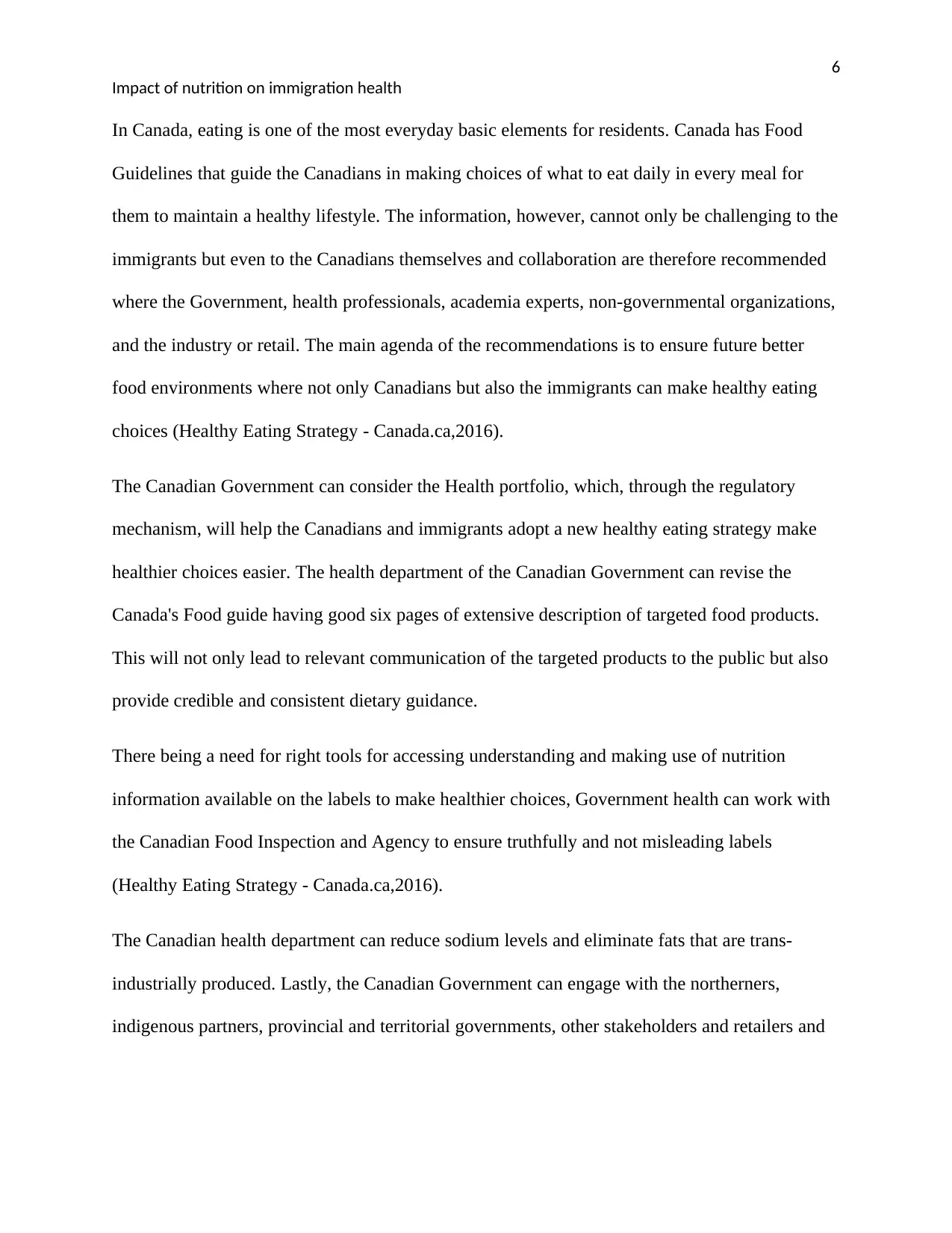
6
Impact of nutrition on immigration health
In Canada, eating is one of the most everyday basic elements for residents. Canada has Food
Guidelines that guide the Canadians in making choices of what to eat daily in every meal for
them to maintain a healthy lifestyle. The information, however, cannot only be challenging to the
immigrants but even to the Canadians themselves and collaboration are therefore recommended
where the Government, health professionals, academia experts, non-governmental organizations,
and the industry or retail. The main agenda of the recommendations is to ensure future better
food environments where not only Canadians but also the immigrants can make healthy eating
choices (Healthy Eating Strategy - Canada.ca,2016).
The Canadian Government can consider the Health portfolio, which, through the regulatory
mechanism, will help the Canadians and immigrants adopt a new healthy eating strategy make
healthier choices easier. The health department of the Canadian Government can revise the
Canada's Food guide having good six pages of extensive description of targeted food products.
This will not only lead to relevant communication of the targeted products to the public but also
provide credible and consistent dietary guidance.
There being a need for right tools for accessing understanding and making use of nutrition
information available on the labels to make healthier choices, Government health can work with
the Canadian Food Inspection and Agency to ensure truthfully and not misleading labels
(Healthy Eating Strategy - Canada.ca,2016).
The Canadian health department can reduce sodium levels and eliminate fats that are trans-
industrially produced. Lastly, the Canadian Government can engage with the northerners,
indigenous partners, provincial and territorial governments, other stakeholders and retailers and
Impact of nutrition on immigration health
In Canada, eating is one of the most everyday basic elements for residents. Canada has Food
Guidelines that guide the Canadians in making choices of what to eat daily in every meal for
them to maintain a healthy lifestyle. The information, however, cannot only be challenging to the
immigrants but even to the Canadians themselves and collaboration are therefore recommended
where the Government, health professionals, academia experts, non-governmental organizations,
and the industry or retail. The main agenda of the recommendations is to ensure future better
food environments where not only Canadians but also the immigrants can make healthy eating
choices (Healthy Eating Strategy - Canada.ca,2016).
The Canadian Government can consider the Health portfolio, which, through the regulatory
mechanism, will help the Canadians and immigrants adopt a new healthy eating strategy make
healthier choices easier. The health department of the Canadian Government can revise the
Canada's Food guide having good six pages of extensive description of targeted food products.
This will not only lead to relevant communication of the targeted products to the public but also
provide credible and consistent dietary guidance.
There being a need for right tools for accessing understanding and making use of nutrition
information available on the labels to make healthier choices, Government health can work with
the Canadian Food Inspection and Agency to ensure truthfully and not misleading labels
(Healthy Eating Strategy - Canada.ca,2016).
The Canadian health department can reduce sodium levels and eliminate fats that are trans-
industrially produced. Lastly, the Canadian Government can engage with the northerners,
indigenous partners, provincial and territorial governments, other stakeholders and retailers and
⊘ This is a preview!⊘
Do you want full access?
Subscribe today to unlock all pages.

Trusted by 1+ million students worldwide
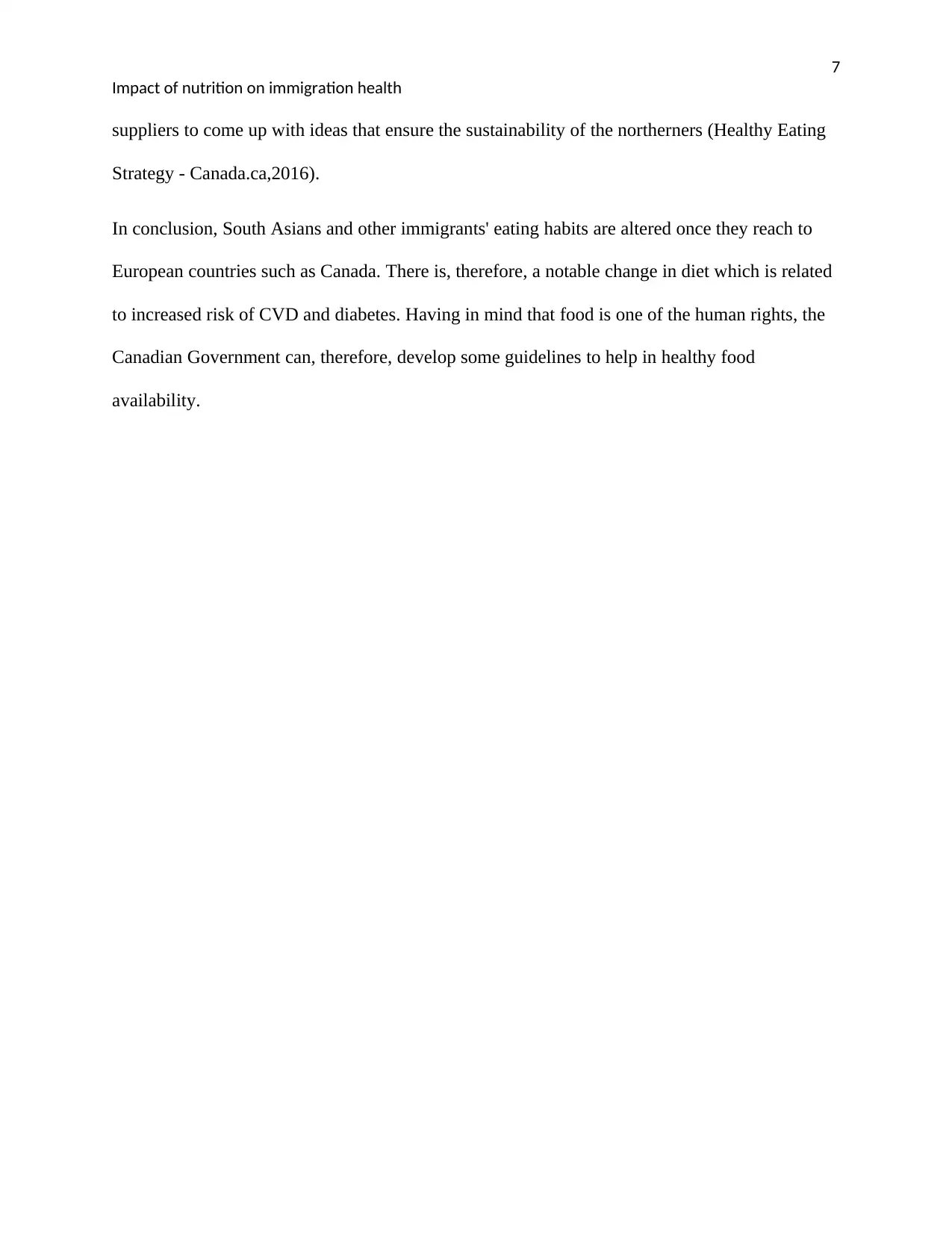
7
Impact of nutrition on immigration health
suppliers to come up with ideas that ensure the sustainability of the northerners (Healthy Eating
Strategy - Canada.ca,2016).
In conclusion, South Asians and other immigrants' eating habits are altered once they reach to
European countries such as Canada. There is, therefore, a notable change in diet which is related
to increased risk of CVD and diabetes. Having in mind that food is one of the human rights, the
Canadian Government can, therefore, develop some guidelines to help in healthy food
availability.
Impact of nutrition on immigration health
suppliers to come up with ideas that ensure the sustainability of the northerners (Healthy Eating
Strategy - Canada.ca,2016).
In conclusion, South Asians and other immigrants' eating habits are altered once they reach to
European countries such as Canada. There is, therefore, a notable change in diet which is related
to increased risk of CVD and diabetes. Having in mind that food is one of the human rights, the
Canadian Government can, therefore, develop some guidelines to help in healthy food
availability.
Paraphrase This Document
Need a fresh take? Get an instant paraphrase of this document with our AI Paraphraser
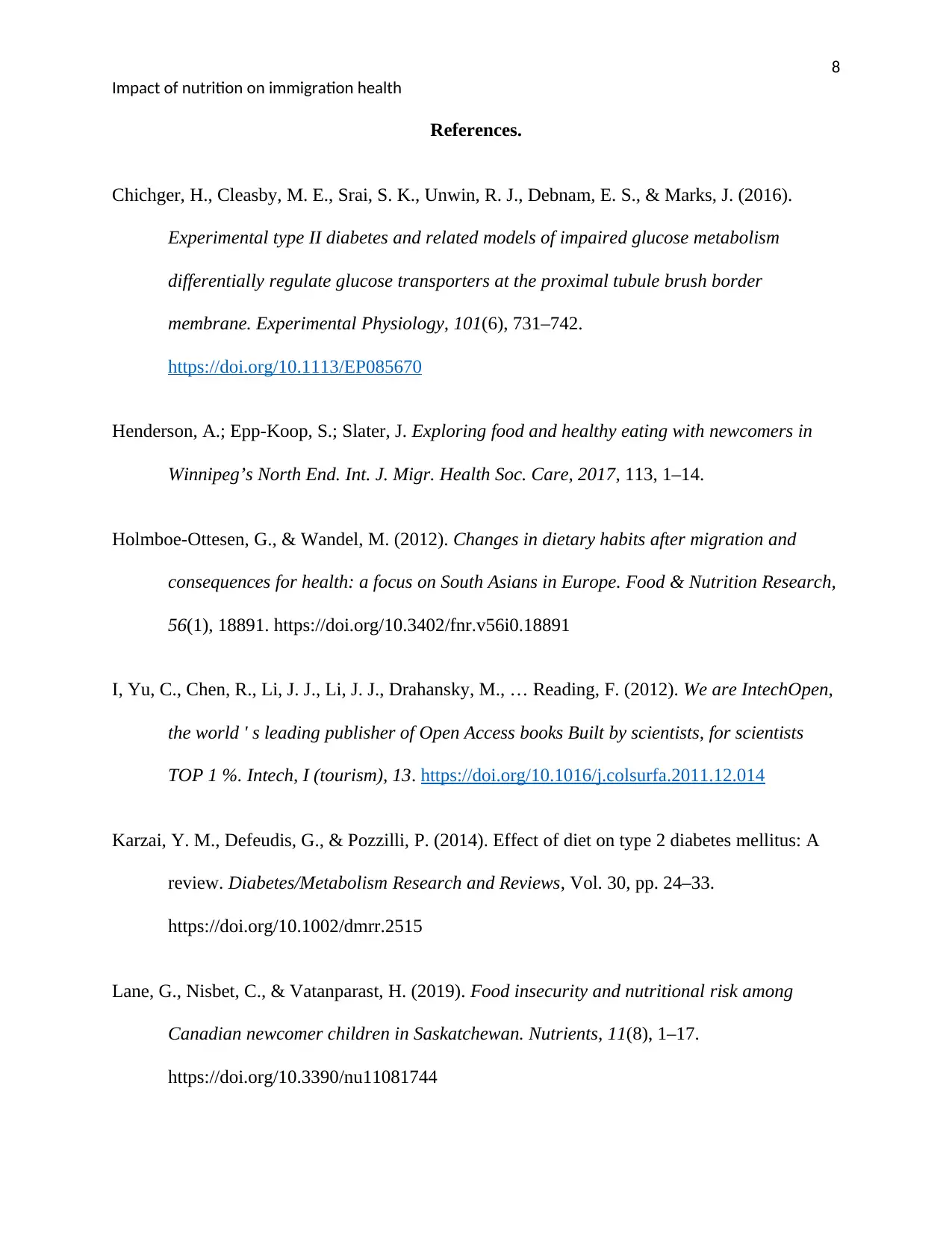
8
Impact of nutrition on immigration health
References.
Chichger, H., Cleasby, M. E., Srai, S. K., Unwin, R. J., Debnam, E. S., & Marks, J. (2016).
Experimental type II diabetes and related models of impaired glucose metabolism
differentially regulate glucose transporters at the proximal tubule brush border
membrane. Experimental Physiology, 101(6), 731–742.
https://doi.org/10.1113/EP085670
Henderson, A.; Epp-Koop, S.; Slater, J. Exploring food and healthy eating with newcomers in
Winnipeg’s North End. Int. J. Migr. Health Soc. Care, 2017, 113, 1–14.
Holmboe-Ottesen, G., & Wandel, M. (2012). Changes in dietary habits after migration and
consequences for health: a focus on South Asians in Europe. Food & Nutrition Research,
56(1), 18891. https://doi.org/10.3402/fnr.v56i0.18891
I, Yu, C., Chen, R., Li, J. J., Li, J. J., Drahansky, M., … Reading, F. (2012). We are IntechOpen,
the world ' s leading publisher of Open Access books Built by scientists, for scientists
TOP 1 %. Intech, I (tourism), 13. https://doi.org/10.1016/j.colsurfa.2011.12.014
Karzai, Y. M., Defeudis, G., & Pozzilli, P. (2014). Effect of diet on type 2 diabetes mellitus: A
review. Diabetes/Metabolism Research and Reviews, Vol. 30, pp. 24–33.
https://doi.org/10.1002/dmrr.2515
Lane, G., Nisbet, C., & Vatanparast, H. (2019). Food insecurity and nutritional risk among
Canadian newcomer children in Saskatchewan. Nutrients, 11(8), 1–17.
https://doi.org/10.3390/nu11081744
Impact of nutrition on immigration health
References.
Chichger, H., Cleasby, M. E., Srai, S. K., Unwin, R. J., Debnam, E. S., & Marks, J. (2016).
Experimental type II diabetes and related models of impaired glucose metabolism
differentially regulate glucose transporters at the proximal tubule brush border
membrane. Experimental Physiology, 101(6), 731–742.
https://doi.org/10.1113/EP085670
Henderson, A.; Epp-Koop, S.; Slater, J. Exploring food and healthy eating with newcomers in
Winnipeg’s North End. Int. J. Migr. Health Soc. Care, 2017, 113, 1–14.
Holmboe-Ottesen, G., & Wandel, M. (2012). Changes in dietary habits after migration and
consequences for health: a focus on South Asians in Europe. Food & Nutrition Research,
56(1), 18891. https://doi.org/10.3402/fnr.v56i0.18891
I, Yu, C., Chen, R., Li, J. J., Li, J. J., Drahansky, M., … Reading, F. (2012). We are IntechOpen,
the world ' s leading publisher of Open Access books Built by scientists, for scientists
TOP 1 %. Intech, I (tourism), 13. https://doi.org/10.1016/j.colsurfa.2011.12.014
Karzai, Y. M., Defeudis, G., & Pozzilli, P. (2014). Effect of diet on type 2 diabetes mellitus: A
review. Diabetes/Metabolism Research and Reviews, Vol. 30, pp. 24–33.
https://doi.org/10.1002/dmrr.2515
Lane, G., Nisbet, C., & Vatanparast, H. (2019). Food insecurity and nutritional risk among
Canadian newcomer children in Saskatchewan. Nutrients, 11(8), 1–17.
https://doi.org/10.3390/nu11081744
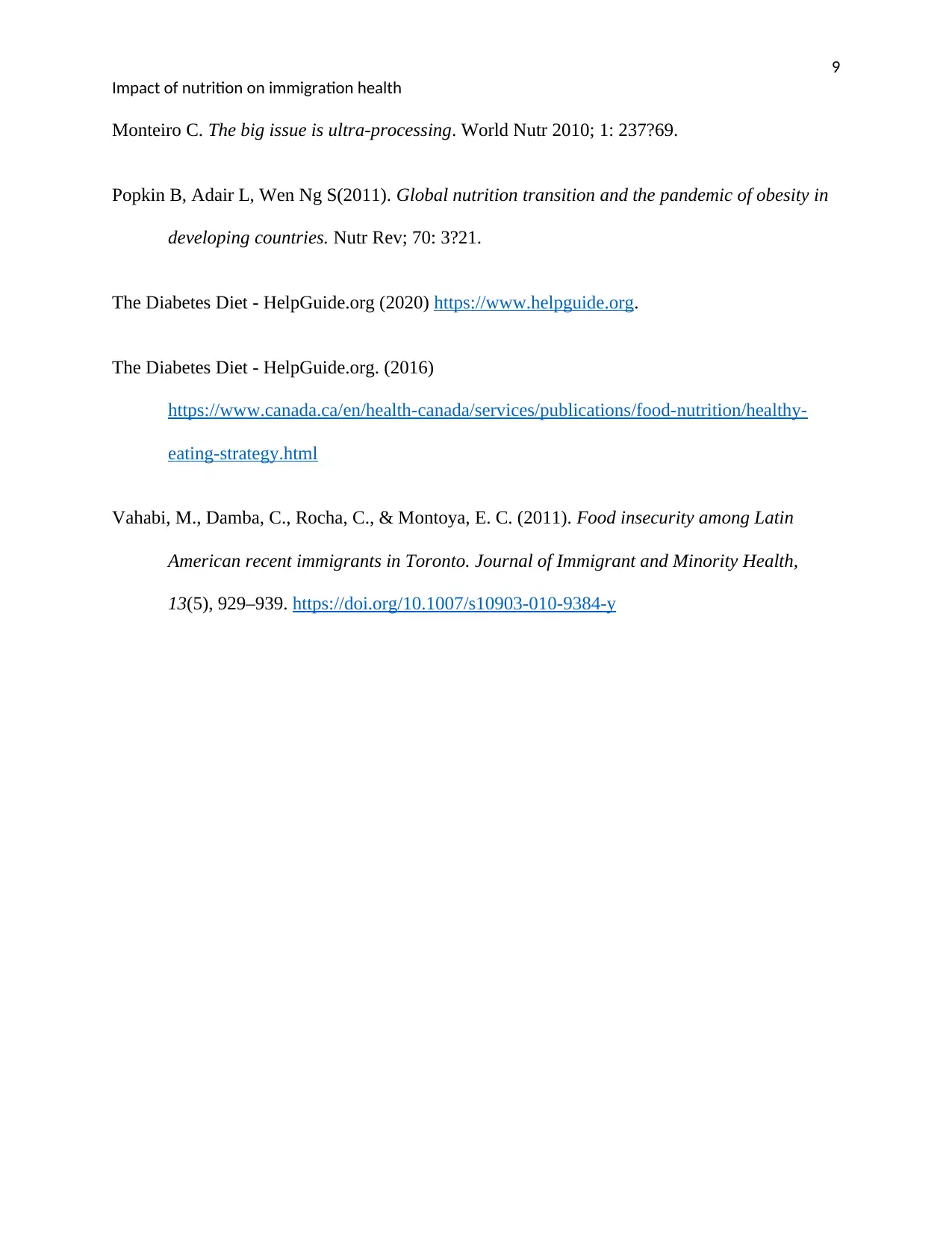
9
Impact of nutrition on immigration health
Monteiro C. The big issue is ultra-processing. World Nutr 2010; 1: 237?69.
Popkin B, Adair L, Wen Ng S(2011). Global nutrition transition and the pandemic of obesity in
developing countries. Nutr Rev; 70: 3?21.
The Diabetes Diet - HelpGuide.org (2020) https://www.helpguide.org.
The Diabetes Diet - HelpGuide.org. (2016)
https://www.canada.ca/en/health-canada/services/publications/food-nutrition/healthy-
eating-strategy.html
Vahabi, M., Damba, C., Rocha, C., & Montoya, E. C. (2011). Food insecurity among Latin
American recent immigrants in Toronto. Journal of Immigrant and Minority Health,
13(5), 929–939. https://doi.org/10.1007/s10903-010-9384-y
Impact of nutrition on immigration health
Monteiro C. The big issue is ultra-processing. World Nutr 2010; 1: 237?69.
Popkin B, Adair L, Wen Ng S(2011). Global nutrition transition and the pandemic of obesity in
developing countries. Nutr Rev; 70: 3?21.
The Diabetes Diet - HelpGuide.org (2020) https://www.helpguide.org.
The Diabetes Diet - HelpGuide.org. (2016)
https://www.canada.ca/en/health-canada/services/publications/food-nutrition/healthy-
eating-strategy.html
Vahabi, M., Damba, C., Rocha, C., & Montoya, E. C. (2011). Food insecurity among Latin
American recent immigrants in Toronto. Journal of Immigrant and Minority Health,
13(5), 929–939. https://doi.org/10.1007/s10903-010-9384-y
⊘ This is a preview!⊘
Do you want full access?
Subscribe today to unlock all pages.

Trusted by 1+ million students worldwide
1 out of 9
Your All-in-One AI-Powered Toolkit for Academic Success.
+13062052269
info@desklib.com
Available 24*7 on WhatsApp / Email
![[object Object]](/_next/static/media/star-bottom.7253800d.svg)
Unlock your academic potential
Copyright © 2020–2025 A2Z Services. All Rights Reserved. Developed and managed by ZUCOL.

